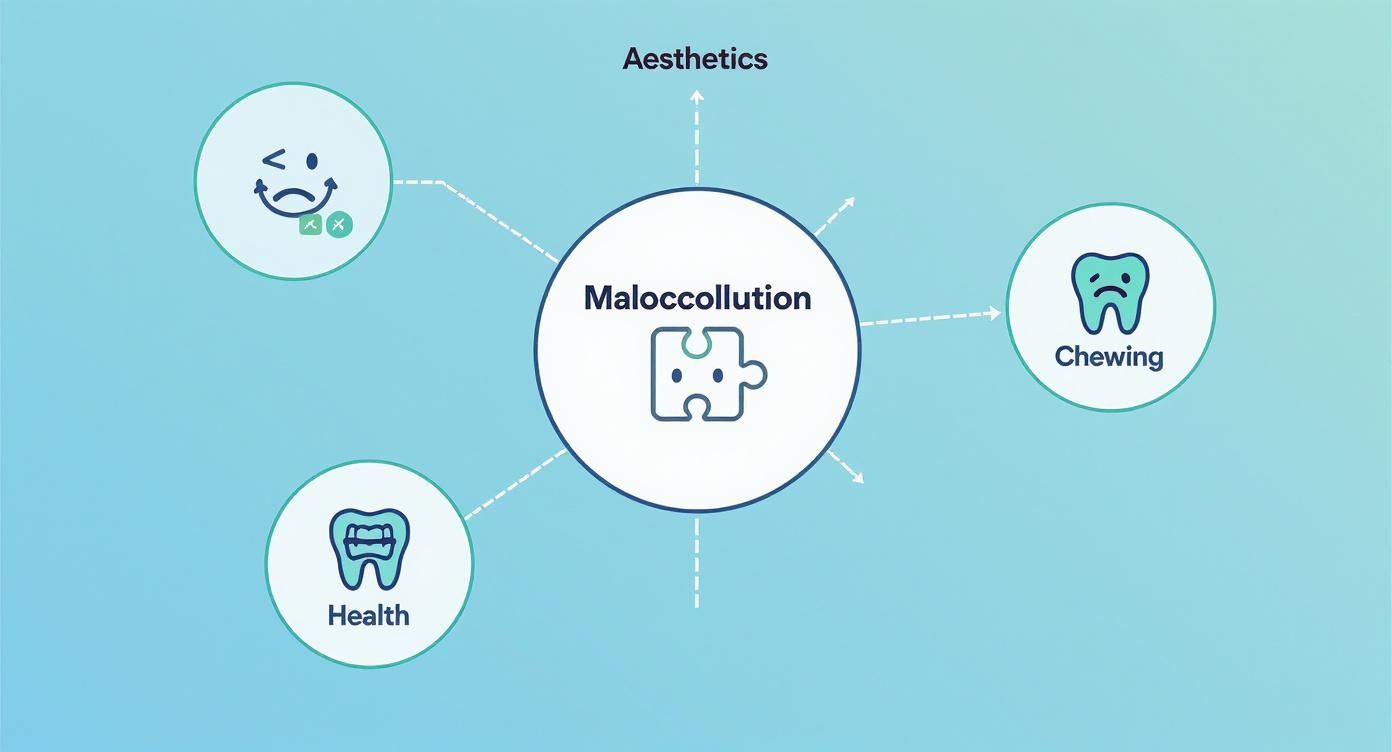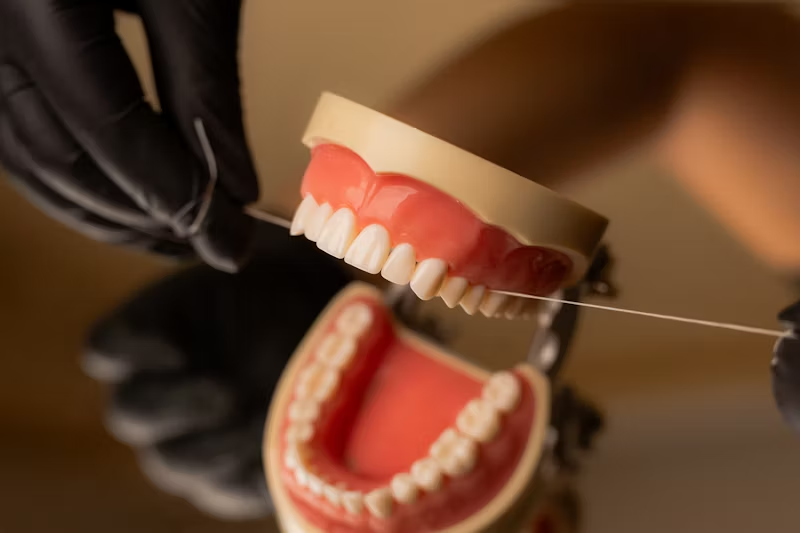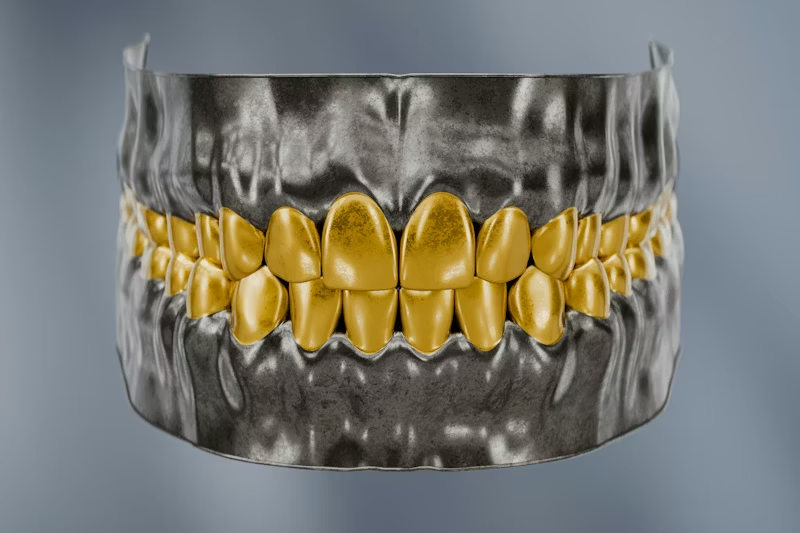What Is Malocclusion and How Is It Treated

When you hear the term “malocclusion,” it’s easy to think it just means crooked teeth. But it’s a bit more than that. It’s the official dental term for teeth that don’t line up correctly when you bite down. This misalignment—what many people call a “bad bite”—can have a real impact on everything from how you chew and speak to how you feel about your smile.
What Does a ‘Bad Bite’ Actually Mean?
Think of your top and bottom teeth as two gears in a finely tuned machine. When they mesh together perfectly, everything works efficiently. But if those gears are out of sync, they can grind against each other, cause strain, and eventually lead to bigger mechanical failures. That’s a pretty good picture of what happens with malocclusion. It’s not just about looks; it’s a genuine oral health issue.
When your bite is off-kilter, it can kickstart a domino effect of problems that go far beyond the mirror:
- Trouble Chewing: You might find it genuinely difficult to bite into an apple or properly grind down tougher foods.
- Accelerated Wear and Tear: Teeth that clash instead of fitting together can wear down your precious enamel much faster than they should.
- Cleaning Becomes a Chore: Crooked or overlapping teeth create sneaky hiding spots for plaque, raising your risk of cavities and gum disease.
- Jaw Pain and Strain: An uneven bite can put your jaw muscles and joints under constant stress, sometimes leading to persistent aches and pains (often called TMJ or TMD).
Just How Common Is It?
You might be surprised to learn how widespread malocclusion is. It’s one of the most common dental problems we see in the UK, affecting a huge number of people right from childhood.
To put it into perspective, the National Child Dental Health Survey back in 2003 revealed that around 35% of children in Scotland had some degree of malocclusion. This really highlights how early these bite issues can start to show up.
The good news? Pinpointing and treating a bad bite is more straightforward than ever. Thanks to modern approaches, getting a professional assessment is no longer a hassle. Services like Toothfairy offer a smarter and more affordable way to straighten teeth by allowing you to get a dentist’s opinion on your bite from the comfort of your own home, making that first step towards a healthier smile both smart and affordable.
The Different Flavours of Malocclusion
To really get a handle on what a “bad bite” can look like, it helps to know the main categories dentists work with. While every mouth is unique, most alignment problems fall into one of a few key types.
A proper bite does more than create a beautiful smile; it establishes a foundation for better oral health, preventing unnecessary wear on your teeth and reducing strain on your jaw.
To make things simpler, here’s a quick summary of the most common types of malocclusion and what makes each one distinct.
A Quick Guide to Malocclusion Types
| Technical Name | Common Term | Primary Characteristic |
|---|---|---|
| Class I Malocclusion | Crowding or Spacing | The overall bite is okay, but individual teeth are jumbled, crooked, or have noticeable gaps. |
| Class II Malocclusion | Overbite or Overjet | The upper jaw and teeth sit too far forward, significantly overlapping the lower teeth. |
| Class III Malocclusion | Underbite | The lower jaw and teeth jut forward, sitting in front of the upper teeth when biting down. |
This table gives you a snapshot of the main classifications, but we’ll dive into what each of these looks and feels like in the real world next.
Understanding the Different Types of Malocclusion
So, we’ve covered what malocclusion is in general, but what does it actually look like? Dentists have a system for classifying different types of bite problems, which is the first step in figuring out the best way to fix them.
Think of these classifications less like technical jargon and more like a map that describes exactly how your teeth meet, function, and look. Getting to grips with them can help you spot what might be going on with your own smile.
The Main Classifications of Bite
Orthodontists primarily use a system called Angle’s Classification. It sounds complex, but it’s really just a way of looking at the relationship between the first big molars on your top and bottom jaws. This simple check-in point allows us to divide most bite issues into three main classes.
A major review of UK studies found that 51.9% of orthodontic cases were Class I, 23.8% were Class II (overbites), and a much smaller 6.5% were Class III (underbites). It’s a great snapshot of how common each issue is. You can dig deeper into the prevalence of these orthodontic conditions in the UK to see the full picture.
Class I: The Misaligned Bite
Class I malocclusion is by far the most common. In this situation, your back teeth (the molars) actually line up correctly, which we consider a ‘normal’ bite. The problem lies with the other teeth.
This is where you see some of the most familiar alignment issues:
- Crowding: There simply isn’t enough room in the jaw, so teeth get twisted, overlapped, or pushed out of line.
- Spacing: You have noticeable gaps between teeth. This might be because your teeth are a bit small for your jaw, or perhaps you’re missing a tooth.
Even though the back bite is okay, crowding and spacing can make it tough to keep your teeth clean and can really knock your confidence.
Class II: The Overbite
Class II malocclusion is what most of us know as an overbite. Technically, it’s an overjet, where the upper jaw and front teeth stick out too far beyond the lower jaw and teeth. This can sometimes make the lower jaw seem small or like it’s set too far back.
This isn’t just a cosmetic issue. An overbite can make it hard to bite into food properly, can contribute to speech issues, and leaves the front teeth more vulnerable to being chipped or damaged.
A malocclusion is more than a cosmetic concern; it’s a functional puzzle involving aesthetics, chewing efficiency, and long-term dental health.
This concept map shows how a misaligned bite is connected to these three crucial parts of your wellbeing.

As you can see, getting your teeth aligned is a holistic step towards improving your overall quality of life.
Class III: The Underbite
Finally, there’s Class III malocclusion, or what everyone calls an underbite. This is the opposite of an overbite. The lower jaw pushes forward, causing the bottom front teeth to sit in front of the top front teeth when you close your mouth.
This can create a prominent chin and often leads to real challenges with chewing and even speaking clearly.
Other Common Alignment Problems
Beyond these three main classes, a few other specific issues pop up frequently:
- Crossbite: This happens when you bite down and some of your upper teeth get trapped inside your lower teeth. It can affect just the front teeth or the back teeth.
- Open Bite: Here, the front or side teeth don’t meet at all when the back teeth are closed, leaving a persistent gap between them.
Figuring out which type of malocclusion you have is the essential first step. With convenient services like Toothfairy, getting a professional diagnosis and looking into affordable, dentist-supervised clear aligner treatment has never been more straightforward.
What’s Behind a Misaligned Bite? From Genetics to Habits
Ever wondered why your teeth grew in the way they did? The answer isn’t a single “aha!” moment. It’s usually a mix of factors, blending the genetic code you were born with, key events during your childhood, and even small, repetitive habits you might not have noticed. Unpacking these causes helps you understand the story behind your own smile.
A huge piece of the puzzle is genetics. You get your eye colour from your parents, and the same goes for things like your jaw size and the shape of your teeth. It’s not uncommon to inherit a smaller jaw from one parent and larger teeth from another—a classic recipe for crowding when there just isn’t enough room for everything to fit.
The Blueprint vs. The Build: Inherited Traits and Developmental Hiccups
While your genes lay down the initial blueprint, how that plan gets built is influenced by what happens as you grow. Think of it as the difference between an architect’s drawings and the actual construction process—things can happen along the way.
Here are a few key developmental factors that can steer things off course:
- Losing Baby Teeth Too Soon: If a baby tooth is knocked out or has to be removed early, the neighbouring teeth often start to drift into the gap. This can block the permanent tooth underneath, forcing it to come through in an awkward position.
- Facial Trauma: A serious knock to the jaw or face during childhood can disrupt its normal growth, sometimes leading to a crooked bite later on.
- Poor Nutrition: A balanced diet is critical for building strong bones and teeth. Missing out on essential nutrients can affect how the jaw develops and how teeth emerge.
How Seemingly Harmless Habits Can Reshape Your Smile
Beyond your DNA and major developmental events, some everyday habits can have a surprising impact. These are often gentle, consistent pressures that, over many months or years, can slowly but surely nudge teeth out of their ideal positions.
“Your teeth aren’t set in stone; their position is a constant balancing act of forces. A habit like thumb-sucking applies a steady, gentle pressure that can move teeth just as effectively as braces can.”
Some of the most common culprits include:
- Prolonged Thumb-Sucking or Dummy Use: If a child continues this habit past the age of three or four, the constant pressure on the front teeth can cause them to protrude, often creating an open bite where the top and bottom teeth don’t meet.
- Mouth Breathing: When someone breathes through their mouth all the time (often due to allergies or blocked sinuses), their tongue rests low in the mouth instead of against the palate. This can lead to a narrower upper jaw and not enough space for the teeth, causing crowding.
- Tongue Thrusting: This is a swallowing pattern where the tongue pushes forward against the teeth. Over and over, thousands of times a day, that little push can gradually create gaps or an open bite.
How to Recognise the Signs and Get a Diagnosis
Spotting the early signs of a misaligned bite often happens right in your own home, long before you ever sit in a dentist’s chair. Some problems, like obviously crooked or crowded teeth, are easy to see. But other clues can be far more subtle. Learning to spot them is the first step toward figuring out if your bite needs a closer look.
Do you ever feel a bit of discomfort when chewing? Or maybe you find yourself accidentally biting the inside of your cheek more often than you’d like. Even small changes in your speech, like developing a slight lisp, can sometimes point back to how your teeth are meeting. Take a look in the mirror: do your top and bottom teeth line up nicely, or does your jaw seem to jut out or sit too far back? These are all classic signs.

What to Expect from a Professional Diagnosis
If you think you might have a malocclusion, your next port of call is a professional assessment. A dentist or orthodontist will follow a clear process to get the full story of your oral health.
Here’s what that typically involves:
- Clinical Examination: The dentist will have a good look at your teeth, jaw, and overall facial structure. They’ll ask you to bite down so they can see exactly how everything comes together.
- Dental Records: This is all about gathering data. Expect photos of your face and teeth, and either traditional plaster moulds or modern digital scans to create a precise 3D model of your mouth.
- Imaging: X-rays are essential. They let your dentist see what’s going on beneath the gums, revealing the precise position of tooth roots and the underlying jawbone structure.
For more complicated cases, advanced imaging techniques like digital volume tomography (DVT) might be used to get an incredibly detailed, 3D view of your craniofacial anatomy. It’s this level of detail that allows for a truly customised treatment plan.
Getting a diagnosis isn’t just about identifying a problem. It’s about creating a clear, effective roadmap to a healthier and more comfortable smile.
A Smarter, More Convenient Way to Get Assessed
The need for orthodontic treatment in the UK is surprisingly common. In fact, studies show that a clinical need for orthodontic care affects between 30.5% and 33% of the population. That’s nearly a third of us who could benefit from correcting a malocclusion.
The good news is that getting that initial assessment doesn’t have to mean booking multiple appointments and taking time off work. At Toothfairy, we’ve made the process incredibly straightforward. We bring the expertise to you with at-home impression kits and secure virtual consultations. A UK-registered dentist reviews your specific case and designs a personalised treatment plan, giving you an affordable and hassle-free start to your smile journey.
A Look at Your Modern Treatment Options
So, you’ve got a diagnosis. The next big question is, what’s the best way to get that straighter, healthier smile? It’s a different world now than it was a decade or two ago; you’re not just stuck with the classic metal-and-wire setup. The right choice for you will really come down to your specific bite issues, your lifestyle, and what you prioritise—be it discretion, comfort, or sheer convenience.
Orthodontics has come a long way, and the old-school “train track” braces are no longer the only game in town. They certainly get the job done, but they come with a few trade-offs that just don’t work for everyone. Thankfully, that’s paved the way for some really smart, modern alternatives.
Traditional Fixed Braces: The Tried-and-Tested Route
For years, fixed metal braces have been the workhorse of orthodontics, capable of tackling even the most stubborn cases of malocclusion. The system is straightforward: small metal brackets are glued to your teeth and connected by a thin archwire. Your orthodontist then regularly tightens this wire, which applies a slow, steady pressure that coaxes your teeth into their proper positions over time.
While they are undeniably effective, they do have a few well-known downsides:
- Aesthetics: They’re very noticeable, which can be a real sticking point for many adults and self-conscious teenagers.
- Comfort: The brackets and wires can rub against your cheeks and gums, causing irritation, especially right after an adjustment.
- Dietary Restrictions: You’ll have a list of forbidden foods—anything hard, sticky, or chewy is off-limits to avoid breaking a bracket.
Clear Aligners: The Discreet and Flexible Alternative
This is where things get interesting. Clear aligners have completely changed the patient experience. Instead of fixed hardware, you wear a series of custom-made, transparent plastic trays that fit snugly over your teeth, a bit like a very thin, clear mouthguard. You’ll wear each tray for about two weeks before swapping it for the next one in the series, with each new aligner moving your teeth just a little bit more.
This approach comes with some fantastic real-world perks. The aligners are nearly invisible, so you can straighten your teeth without everyone knowing about it. They are also fully removable, which is a huge plus. You just pop them out to eat, drink, and brush your teeth as you normally would. No food restrictions, no tricky cleaning routines.
Toothfairy has found a smarter way to deliver this treatment. By having UK-registered dentists manage the process remotely, we eliminate expensive clinic overheads. This makes our aligners a more affordable choice than other specific aligner brands, without ever cutting corners on professional quality and care.
Clear Aligners vs Traditional Braces: a Quick Comparison
Let’s put the two main orthodontic options side-by-side to see how they stack up. While both are designed to get you to the same goal—a beautiful, well-aligned smile—the journey with each is quite different.
| Feature | Toothfairy Clear Aligners | Traditional Fixed Braces |
|---|---|---|
| Appearance | Nearly invisible and discreet | Highly visible metal brackets and wires |
| Comfort | Smooth plastic, minimal irritation | Can cause soreness and mouth ulcers |
| Convenience | Removable for eating and cleaning | Fixed in place 24/7, requires special care |
| Diet | No food restrictions | Avoid hard, sticky, and chewy foods |
Ultimately, the best choice depends on what you value most in your treatment experience—flexibility and subtlety, or the sheer power to handle extremely complex cases.
When a More Intensive Approach Is Needed
Sometimes, for very severe cases of malocclusion—especially those where the jaw and skeleton are part of the problem—aligners or braces alone won’t be enough to get the job done right.
In these situations, your dentist might need to look at more intensive treatments. This could involve tooth extractions to make room in a severely crowded mouth, or even orthognathic (jaw) surgery to correct the underlying bone structure. These are serious steps, typically reserved for complex Class II or Class III malocclusions, and would always be part of a carefully planned, comprehensive discussion with your specialist.
Start Your Smile Journey the Smart Way
Fixing a misaligned bite used to be a real hassle, but thankfully, things have changed. Modern dentistry has evolved beyond endless clinic visits, making it possible to get a straighter, healthier smile in a way that actually fits your life.

Here at Toothfairy, we’ve designed our entire process to put you firmly in the driver’s seat. It all kicks off with a simple online assessment. From there, we post an at-home impression kit straight to your door. No more juggling your schedule for multiple appointments just to see if you’re a candidate.
Once your impressions are back with us, our team of UK-registered dentists gets to work. They’ll analyse your unique alignment and create a personalised 3D treatment plan. This isn’t just a vague promise; it’s a clear preview showing you exactly how your smile will transform over time.
This dentist-led, remote approach is what makes professional orthodontic care genuinely accessible. We’ve cut out the expensive overheads of traditional clinics and other aligner brands, passing those significant savings directly on to you.
Your custom-made clear aligners are then produced and delivered. Throughout your treatment, the very same dental professionals who designed your plan will monitor your progress remotely, ensuring everything stays safe, effective, and on track. By blending expert care with smart technology, Toothfairy provides a far more affordable and convenient path to the confident smile you’ve always wanted.
Your Malocclusion Questions Answered
To wrap things up, let’s go through some of the most common questions people have about malocclusion. Getting clear, straightforward answers can help you feel more confident about understanding your bite and what to do next.
Can a Bad Bite Fix Itself Over Time?
Unfortunately, no. A significant malocclusion won’t correct itself and, more often than not, can actually get worse without treatment.
While you might see minor shifts as a child’s jaw grows, bigger problems like severe crowding, crossbites, or a deep overbite need an orthodontist’s help to guide everything into the right place for a healthy, functional bite.
When Should I Get My Child Checked for Malocclusion?
The British Orthodontic Society recommends an initial check-up with an orthodontist around the age of seven.
By this age, enough adult teeth have come through for a specialist to spot any developing issues with jaw growth or alignment. Catching these problems early often means treatment can be simpler and more effective down the line.
Correcting a malocclusion isn’t just about looks. Properly aligned teeth are much easier to keep clean, which dramatically lowers your risk of cavities and gum disease. A good bite also means you can chew properly, reduces strain on your jaw joints, and stops your teeth from wearing down unevenly.
Does Orthodontic Treatment Still Work for Adults?
Absolutely. There’s no age limit on getting a straighter, healthier smile. Teeth can be moved safely and effectively at any stage of life.
Modern options like Toothfairy’s clear aligners are especially popular with adults. They’re discreet, you can take them out to eat, and they fit easily into a busy professional life without the look of traditional braces. Plus, the teledentistry approach makes the whole process far more convenient.
Is Fixing My Bite Just for Cosmetic Reasons?
Not at all. While a great-looking smile is a wonderful result, the health benefits are just as crucial. In fact, correcting a bad bite can have a massive positive impact on your oral health for the rest of your life.
Ready to see if a smarter, more affordable way to straighten your teeth is right for you? Take the first step with Toothfairy and get a professional, dentist-led assessment without leaving your home.
Start Your Free Online Screening Today
Last updated on November 24, 2025

Toothfairy Care Team
Toothfairy, is the world's smartest dental app, that connects patients to a dentist for a range of issues, from emergencies, cosmetics, prescriptions to virtual exams.
Toothfairy Care Team
Toothfairy, is the world's smartest dental app, that connects patients to a dentist for a range of issues, from emergencies, cosmetics, prescriptions to virtual exams.





